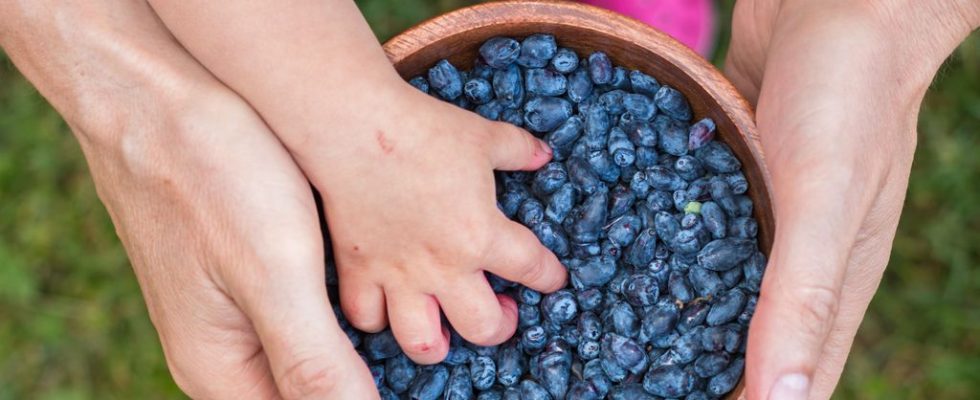The Siberian haskap berry is conquering the superfood market. The berry has a lot of healthy ingredients. But how much is really behind the trend? And can it keep up with regional berries such as blueberries, blackberries and the like?
Do you want to live healthier?
➡ Watch the latest episode of The Biggest Loser on Joyn.
In the video: Superfoods checked with a nutrition expert
Where does the hasap berry come from?
The haskap berry is apparently the new star in the superfood sky. The sweet and tart berry, which looks slightly similar to the blueberry, originally comes from Siberia. She has had many fans in Japan for several years. It is now being grown more and more in Germany. It is rich in antioxidants and is said to provide a variety of health-promoting effects have.
The ingredients of the haskap berry
The haskap berry is also known as blue honeysuckle, Kamchatka honeysuckle, honeyberry or mayberry and is packed with Antioxidants (vitamins A, C and E). These help protect cells from oxidative stress. In addition to many vitamins, it also contains minerals such as iron, magnesium or Calcium. The Vitamin C content The haskap berry ranges between, depending on the growing region 30 and 190 milligrams per 100 grams. For comparison: 100 grams of oranges contain around 53 grams of vitamin C. The dark blue berries taste tart-sweet and like a mixture of blueberries, blackberries and raspberries.
This is how the ones contained in the berry work Vital substances:
- Vitamin C: It supports the immune system, helps prevent colds and has antioxidant properties.
- Vitamin A: It promotes vision and the skin’s self-protection against UV rays and also has an antioxidant effect.
- Vitamin E: It protects cells from harmful environmental influences such as UV radiation, alcohol or tobacco.
- Magnesium: It supports healthy muscle function and is involved in many important metabolic processes in the body.
- Iron: Among other things, it is important for oxygen transport in the cells.
- Calcium: It strengthens teeth, bones and cartilage.
Those contained in the berry are particularly worth mentioning Anthocyanins (secondary plant substances), which are responsible for their blue color and have antioxidant properties. They can protect cells, neutralize free radicals in the body and prevent disease. Anthocyanins should also vascular protective act and Inhibit inflammation can. Due to these ingredients, the haskap berry is considered to lower blood pressure and is said to protect against cardiovascular diseases. However, there is so far no scientific studieswho confirm this.
Uses of Haskap Berry in Cooking
The delicious haskap berries are suitable for eating raw and are also a wonderful addition to fruit salads. In addition, the berries are often processed into fruit powder, jam, juice or syrup. Here are some other ways you can use them:
- As an ingredient in cakes and pastries
- In yogurt or muesli
- For refreshing cocktails and drinks
- As a delicious compote
In the clip: What are superfoods and which foods are included?
Is the haskap berry really that special?
The Haskap berry offers an advantage because it Ready to harvest from the beginning of May is. In contrast, strawberries, blackberries and similar varieties often came from greenhouses at this time. This extends the berry season forward.
The fresh haskap berries cost between 15 and 30 euros per kilogram, depending on whether they are grown conventionally or organically. This means that the prices are significantly higher than those of other types of berries. So far, haskap berries only available in a few places and are not part of the standard offering in supermarkets or health food stores. The easiest way to source them is directly from regional producers. On this point, conventional berries, which are available everywhere during the season, are ahead.
According to the EU Novel Food Regulation, the haskap berry has only been allowed since 2019 are sold by us. The consumer advice center is rather skeptical about the haskap berry. Regional foods such as blackcurrants, blueberries, blackberries or raspberries similar many vitamins, antioxidants and minerals like the export berries from Eastern Russia and are usually in season cost-effective available.
It is also uncertain whether those contained in the berry Anthocyanins can be absorbed by the body at all. The consumer advice center also points out that the haskap berry and its ingredients, on the one hand Provide protection against oxidative stress could. However, it is not an eventual one “Miracle Berry”which as a single food protects against diseases.

